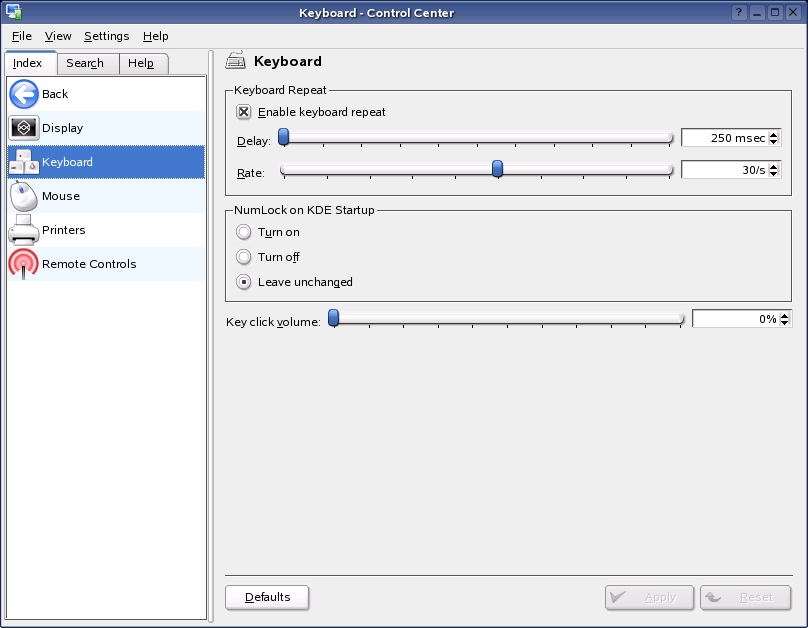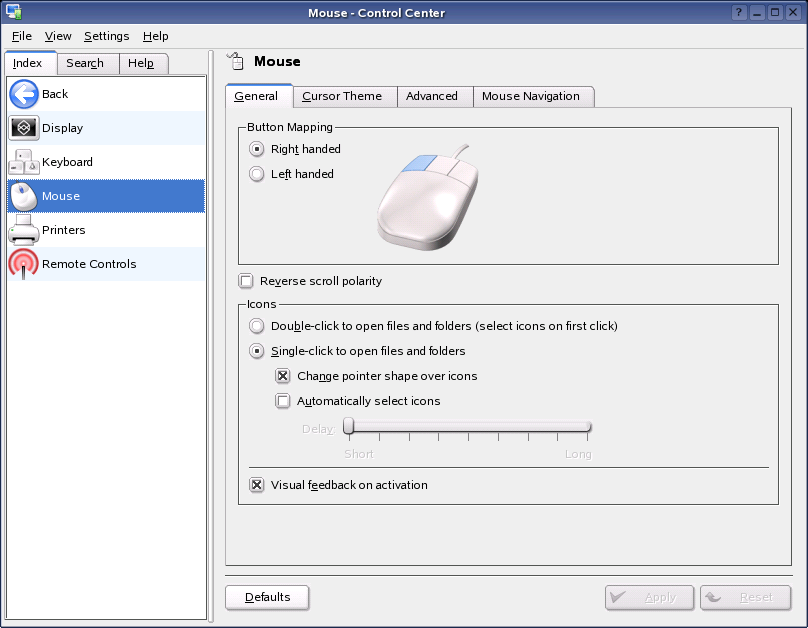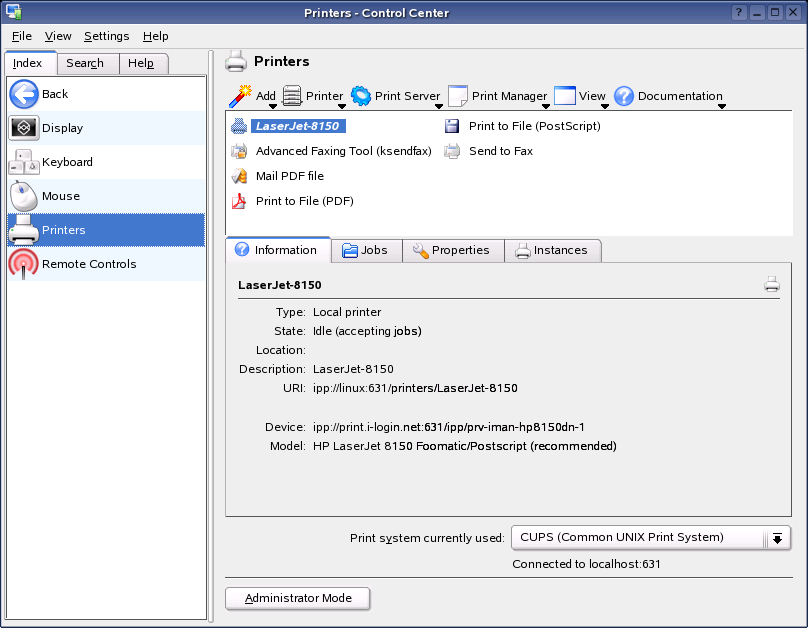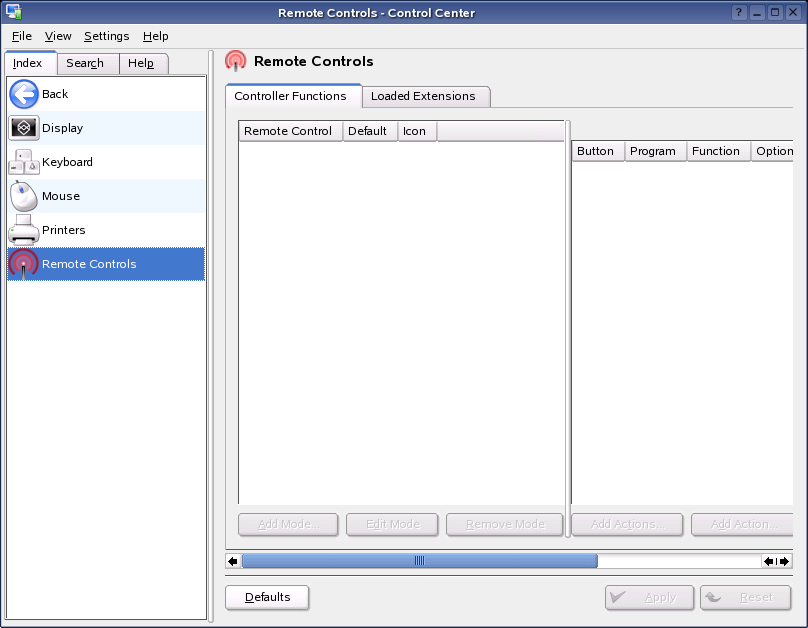3.5 Peripherals Settings
Use the settings under the Peripherals category to change mouse, keyboard, and printer administration configurations.
3.5.1 Modifying Display Settings
Click .
Use this module to modify settings for the size, orientation and refresh rate of your display, and whether you want these settings to be applied on KDE startup. On the tab, you can configure power management options for this screen, such as screen blanking.
Figure 62 KDE Control Center Display Dialog

3.5.2 Configuring Basic Keyboard Settings
Click .
This module allows you to configure basic keyboard settings. These include keyboard repeat delay and rate, and the numlock state on KDE startup.
Figure 63 KDE Control Center Keyboard Dialog

Choose from the following options:
-
Keyboard Repeat:Keeping a key pressed causes the associated character to be printed repeatedly as long as the key is pressed. The option is activated by default.
-
Key Click Volume:If you want to hear a sound when a key is clicked, activate this option and adjust the volume with the slider.
-
Use Sticky Keys, Slow Keys, or Bounce Keys:These options are the same as those listed in Configuring Accessibility Settings, where they are described in detail.
-
NumLock on KDE Startup:Determines whether the number pad of your keyboard should be active when KDE is started.
For information about keyboard accessibility options, see Configuring Keyboard Layouts and Configuring Keyboard Shortcuts.
3.5.3 Configuring Mouse Settings
Click .
Use this module to configure mouse settings. You can switch the button order, reverse the scroll direction, or modify the behavior of clickable icons. You can also preview, install, and select cursor themes. The tab allows you to further fine-tune your mouse settings.
Figure 64 KDE Control Center Mouse Dialog

The mouse configuration includes three tabs: , , and .
The configuration options on the page include:
-
Button Mapping:Specifies right-handed or left-handed use of your mouse.
-
Icons:Determines how the system should react to clicks and double-clicks. The default setting for the KDE desktop is a single click for opening files or folders and a mouse pointer that changes its appearance when it is moved over icons. Select if you want to use double-click for opening files and folders, while a single click only selects icons. You can also set the size and color of the pointer and the visual feedback on activation.
The configuration options on the page include:
-
Pointer Acceleration and Pointer Threshold:The pointer acceleration defines the relation between the movement speed of the input device (mouse) and the speed of the pointer on the screen. The higher the selected factor is, the more difficult it is to control the screen pointer. The threshold (in pixels) specifies the distance the pointer must cover before the indicated pointer acceleration is activated. This lets you easily control the mouse pointer when covering small distances and cover large distances on the screen with small movements.
-
Double Click Interval:Sets the maximum interval between two mouse clicks that should be interpreted as a double-click.
-
Drag Start Time and Drag Start Distance:The object selected with a click is moved if you move it by the distance in pixels specified in Drag Start Distance within the period specified in Drag Start Time.
-
Mouse Wheel Scrolls By:If you have a wheel mouse, this option specifies the number of lines the image should scroll per wheel tooth.
To be able to navigate the mouse pointer with the arrow keys of the number pad, activate this function under Mouse Navigation and customize the parameters according to your needs.
3.5.4 Configuring Printers
Click .
This module lets you configure printers using a variety of print systems. You can add local and remote printers, check current jobs, and look at printer properties.
Figure 65 KDE Control Center Printers Dialog

The printer administration module consists of three parts. The top lists all printers available in the network. The center features a configuration and information are with four tabs. The bottom indicates the current print system type. The following description only covers the configuration part.
HINT: The configuration options relevant for your daily work with the system can be accessed under Jobs and Instances. Information and Properties mainly provide information or are used for system administration.
Depending on which printer is currently selected in the overview, you can view and modify the status and model information and configuration options on the following four tabs:
-
Information:Provides information about the printer, such as the printer type, its status, location, and designation. You cannot modify this information.
-
Jobs:Corresponds to KJobViewer, described in Monitoring Print Jobs.
-
Properties: All settings related to the printer are available here: general information, drivers, interfaces, separator pages, quotas, and user accesses.
-
Instances:Depending on the document type, you might have diverse requirements for the printouts (page format, duplex printing, orientation, print quality, and banners). Combine the characteristic settings for each type in instances. To create a new profile, select New and specify a name for the profile. Click Settings to open a configuration dialog where you can specify these settings. To define one of your custom profiles as the default for this printer, click Set As Default. Your default profile is used when printing from applications. You can switch only between the individual profiles in the printer administration module.
For more information, see Managing Printers.
3.5.5 Configuring Remote Control Buttons
Click .
The Remote Controls module (kcmlirc) lets you configure buttons on remote controls to perform functions in KDE programs. Modes are used to allow the same button to control different actions in different circumstances.
Figure 66 KDE Control Center Remote Controls Dialog

This module requires LIRC, a package that lets you decode and send infrared signals for many commonly used remote controls. For information, see the Linux Infrared Remote Control Web site.